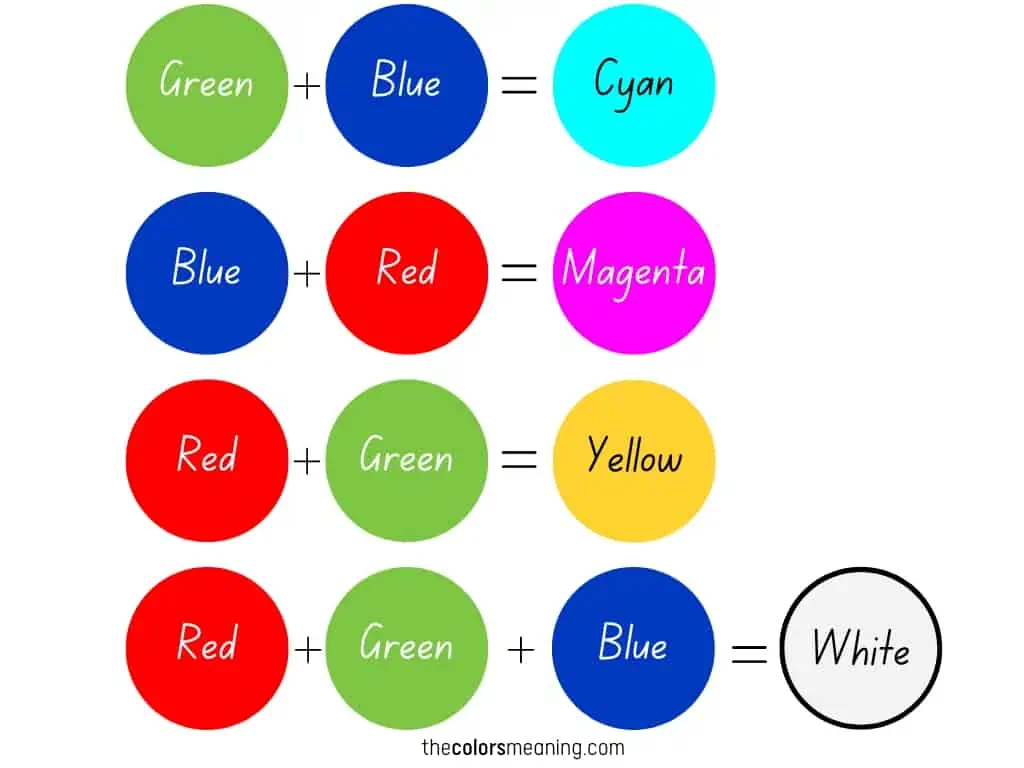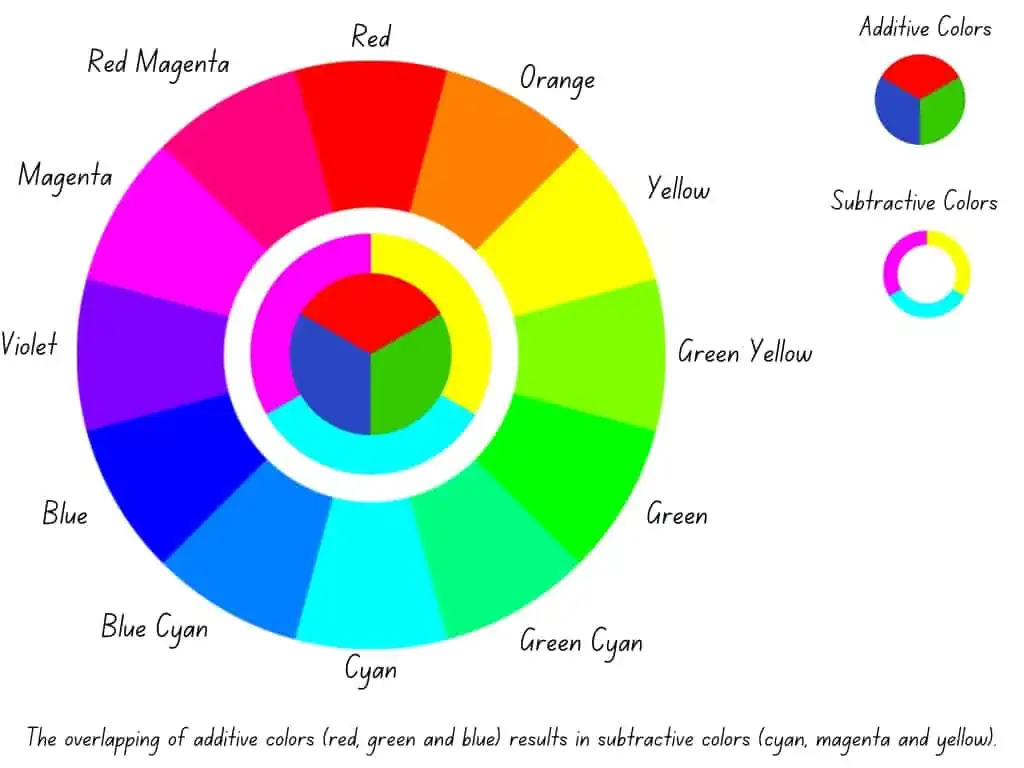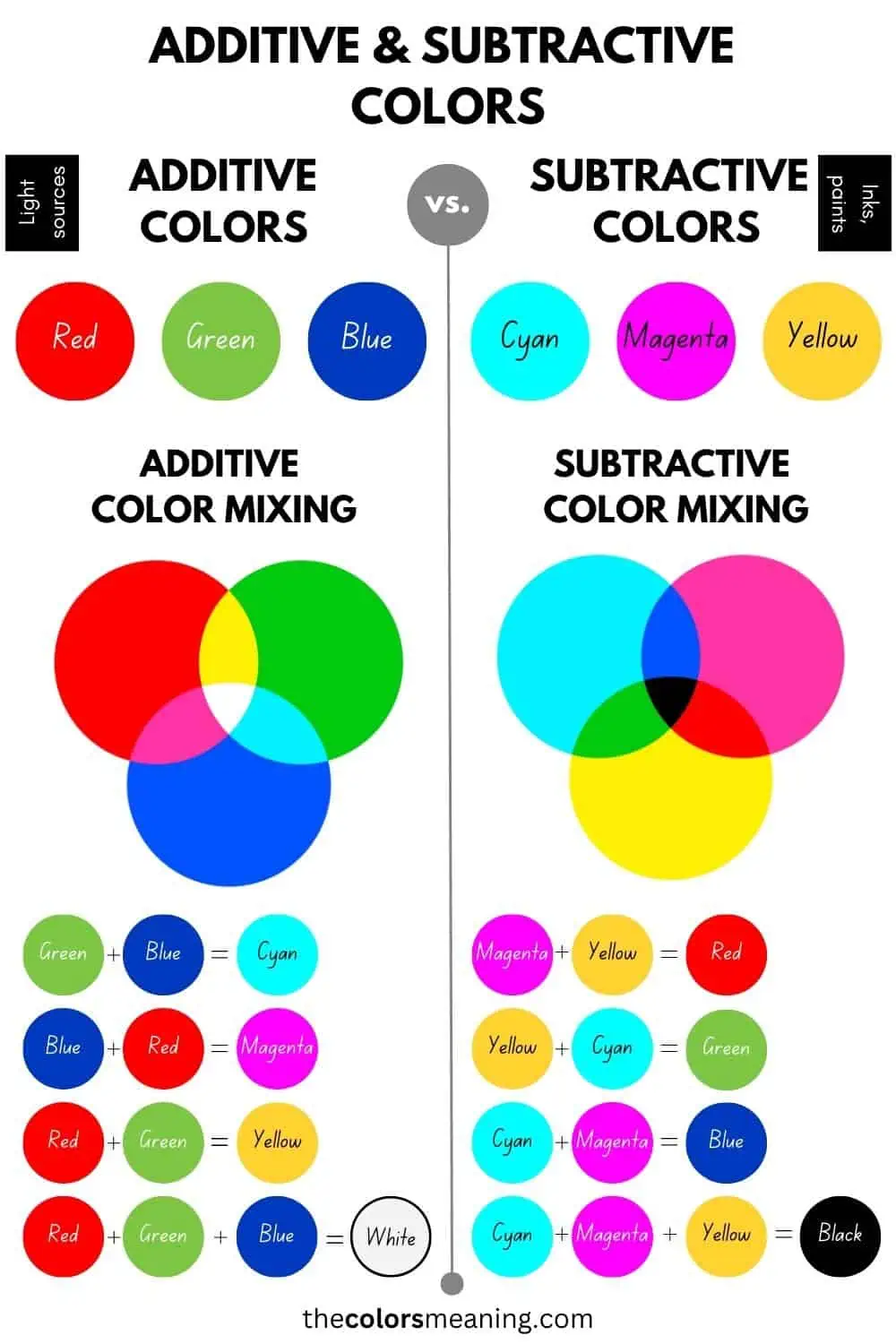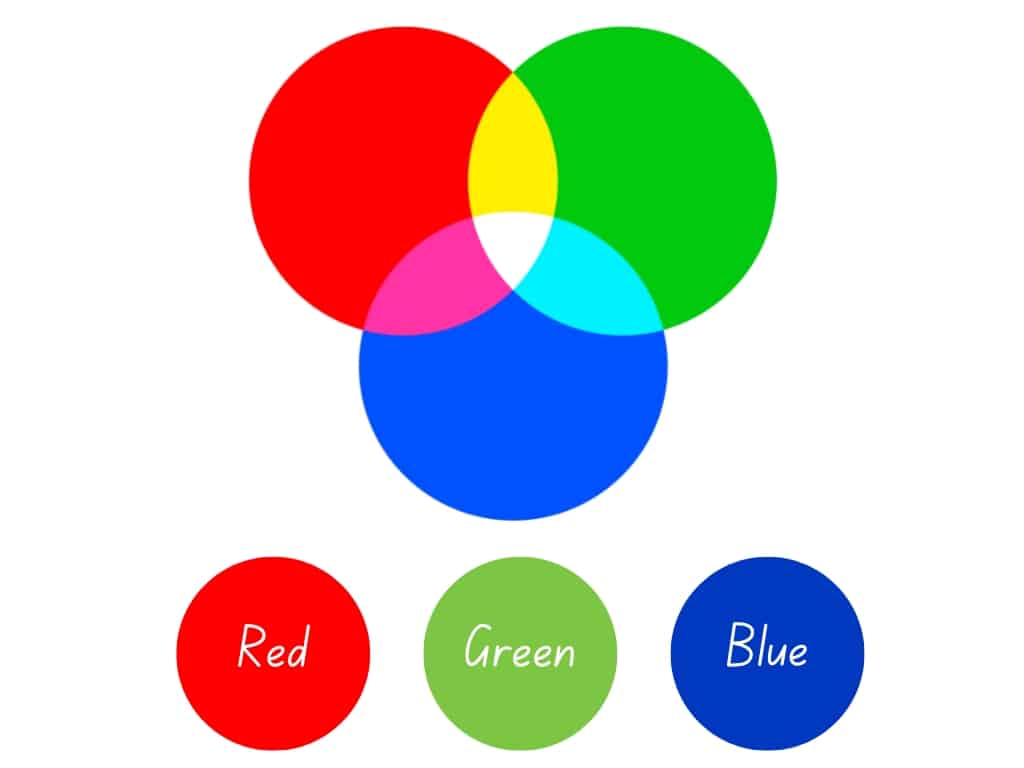Want to know what additive colors are? Here’s everything you need to know about additive colors. Whether you are a digital artist, a beginner, or a graphic designer, you must understand the additive color system.
Additionally, this color system includes an additive color wheel. It has an impact on all aspects of digital life, from digital art to graphic design.
In this article, we’ll define additive colors, explain why they’re important in color theory, and explain how additive color mixing works. We will also show you the additive color wheel. Let’s find out more!
The Science Behind the Additive Primary Colors
The additive color model derives from how the human eye interacts with light to produce colors. In particular, the human eye sends signals to the brain in order to convert light into color. But how does this happen?
There are two types of photoreceptors in the human eye called rods and cones. If rods help us see in low light, cones help us see in high light levels.
Each receptor in your eye contains approximately 120 million. This is also why our peripheral vision is less colorful and sharp than our frontal vision.
While the rods are highly sensitive to light and are responsible for night vision, the cones are in charge of color vision because they can detect a wide spectrum of light photons.
So, the cones’ property is color vision. In short, the perception of color to discriminate objects is based on the wavelength distribution of the light reflected from them to your eye. [1]
Unlike rods with only one photopigment, cones have three different photopigments.
The cones in the human eye are sensitive to different wavelengths of light. For example, one type is more sensitive to red light, another to green light, and the third to blue light.
That’s why the cone types are referred to as “blue,” “green,” and “red.” In addition, because of their spectral sensitivities, scientists label the cone types as short, medium, and long wavelength cones.
Human color vision is trichromatic due to the presence of three cone mechanisms. The trichromatic theory was established by Hermann von Helmholtz. [2]
As a result, the primary colors of human color vision are red, green, and blue! This is where the additive theory came from. The RGB color model was developed in response to this sensitivity to red, green, and blue light.
A wide range of colors that closely match the colors we see in the real world can be created by combining different amounts of red, green, and blue light.
What Are Additive Colors?
The absorption of light by the three types of eye cones initiates color vision.
The brain can distinguish thousands of different colors by combining the signals from these cones.
So there are three types of cones in the human retina:
- Short-wavelength cones (blue)
- Medium-wavelength cones (green)
- Long-wavelength cones (red)
We have a trichromatic color vision based on the eye’s cones’ spectral sensitivity. Thus, if you understand the science of color vision, you’ll also understand how this color system works.
So, based on the biology of the human eye and its color perception ability, red, green, and blue are the primary colors of human color vision.
This is also the origin of the RGB color model. It should be noted that this color model is concerned with light, not “material” colors.
Additive color begins with black (lack of light) and adds red, green, and blue light to make colored light. The result becomes brighter as more color is added. Finally, it ends with white light. The white light is a combination of these three colors.
So, by mixing light beams of different wavelengths, you get different colors. That’s why it is called additive color mixing.
Unlike this color system, the subtractive color system starts with white and gets darker as color is added. This is an entirely different color theory concept.
It’s called subtractive color mixing because when we mix paints or inks, certain wavelengths are removed from what we see. This occurs because each pigment absorbs some wavelengths that the other paint reflects. As a result, we have fewer wavelengths remaining.

Additive Color Wheel
Combining lights of different wavelengths is known as additive color mixing.
Whether you call it additive color or additive mixing, this is a property of the RGB color model.
So, the additive color model corresponds to RGB (red, green, blue). Therefore, the additive color wheel aligns with the RGB color wheel.
The primary colors in the additive color wheel are red, green, and blue (RGB). So by mixing these additive primary colors, you get the secondary colors of RGB:
- Green + Blue = Cyan
- Red + Blue = Magenta
- Red + Green = Yellow
Did you notice the colors resulting from additively mixing pairs?
By overlapping the additive primary colors, you get the primary subtractive colors: cyan, magenta, and yellow. These subtractive colors correspond to the CMYK color model.
Moreover, by additively mixing pairs of all additive primary colors, you get white, which is located on the additive color wheel where the beams of all light colors intersect.
- Red + Green + Blue = White
Remember that the additive color model is the exact opposite of the subtractive color model, which is used in traditional printing processes where the ink absorbs specific wavelengths of light.

How Are Additive Colors Used?
As you already know, any digital monitor displays images composed of pixels.
Each pixel in a digital device, such as a computer monitor or television, is made up of red, green, and blue light-emitting diodes (LEDs) or liquid crystal elements.
As a result, each pixel comprises three distinct light sources, one for each primary color. These light sources are referred to as “sub-pixels” because they produce the desired hue in a single pixel.
So, any digital device can display a wide range of colors by varying the intensity of the RGB light (red, green, and blue).
To make white, for example, all three additive primary colors are turned on to their maximum intensity, while all three are turned off to make black.
To create different shades of gray, equal amounts of red, green, and blue are used, and the intensity of these ones is adjusted to create a specific color.
Are you curious about how additive primaries are used in digital displays?
Two examples of display types that come to mind are LCD and OLED.
RGB light sources in an LCD screen (liquid crystal display) are typically light-emitting diodes (LEDs) or compact fluorescent lamps located behind the screen.
The light emitted by these sources is filtered with a color filter. The light is then passed through a layer of liquid crystals, which can be individually controlled to allow or prevent light from passing through.
The LCD screen can thus produce all colors by varying the intensity of these three colors.
In an OLED (organic light-emitting diode) display, each pixel has its own RGB light source in the form of red, green, and blue OLEDs.
The light intensity emitted by each color can be controlled by controlling the current that flows through each OLED. So that’s how all colors are made.
The intensity of each colored light (red, green, and blue light) on both LCD and OLED screens is controlled by the graphics card (in laptops and computers) or a converter (in televisions) through a process known as pulse-width modulation. This modulation is a power control technique.
Additive vs. Subtractive Color Infographic
Additive colors are created by adding colored light to black, whereas subtractive colors are created by absorbing (or subtracting) some light wavelengths while reflecting others.
Are you curious to see a comparison between additive and subtractive colors? Here’s an infographic below.

What is the Applicability of Additive Colors
Additive primary colors are used in a variety of fields, including computer graphics, television and video production, and lighting design.
Laptop and Mobile Displays
When you read this article on your screen, you see the result of additive color mixing. The screen produces this image using red, green, and blue light-emitting diodes (LEDs) or liquid crystal pixels. More specifically, your display regulates the intensity of primary colors of light (RGB) to produce the colors you see.
Television and Video Production
Additive color theory is also used in television and video production. For example, when you watch a TV show, images are created using additive color theory.
Lighting Design
Additive color can also be used in lighting design to create different moods and atmospheres. Lighting designers can create various effects by combining different colors and intensities of light.
Projection-Mapping
The projection mapping technique projects video or images onto surfaces such as buildings or walls.
In order to project the image, this technique employs the RGB additive model, which uses red, green, and blue projectors to produce a full-color image.
These are just a few examples of how the additive color system is used.
Did you find this article interesting? Then please help us by sharing it with your friends who might be interested.

